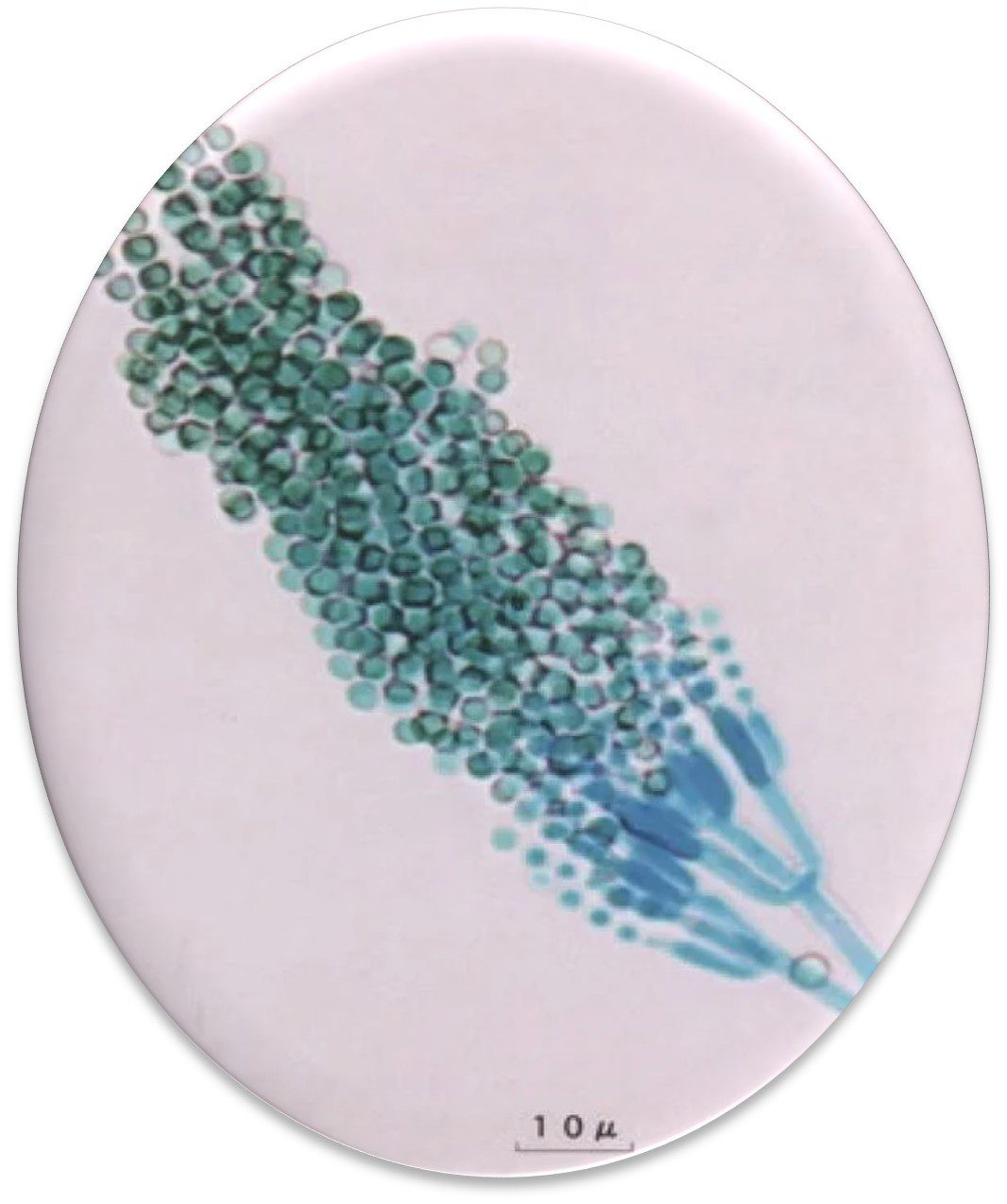
Penicillium citrinum – a common fungal contaminant from water-miscible metalworking fluids. Source: penicillium-citrinum-890c723a-deef-4dea-b2db-de048c4df2a-resize-750.jpg (600×806) (alchetron.com)
Introduction
In my September 2023 post, I provided an overview of bacteria the biological domain that includes millions of taxa that share both genetic similarities and an absence of visible internal structures. After a three-month hiatus, I’ll now provide a similar overview of fungi. Fungi is a kingdom of eucaryotic organisms that are members the domain Eucarya. As illustrated in September’s What’s New post, figure 2, Eucarya includes all organisms that have a membrane-bound nucleus. The domain includes organisms ranging in size from single cell algae to 30 m (98 ft) long, 199 metric ton (219 US ton) blue whales (Figure 1). The kingdom Fungi is taxonomically diverse – including yeasts, molds, and mushrooms (Figure 2 – note: yeasts and molds are two different morphologies; not different taxonomic groups). The fungi associated with industrial process fluids are all within the phyla Ascomycota and Mucromycota (recall from September’s post, that phIyla are the tier below kingdoms).
Fungal Taxonomy
Genera within the phyla Ascomycota (Ascomycetes) and Mucormycota (Zygomycetes) have filamentous, vegetative hyphae and spore-bearing aerial hyphae (Figures 3 and 4). As illustrated in Figure 5, Ascomycota spores are contained in sacs but Mucormycota spores are not. Moreover, some fungal species are dimorphic – they have both filamentous and yeast morphologies (forms – Figure 6). Although historically, fungal taxonomy was based primarily on appearance (morphology) and physiology (eating habits), the discipline is now moving toward genetic classification.

Fig 1. Examples of organisms in the domain Eukarya – a) single-cell alga; b) Giardia sp.; c) fungus (mushroom); d) plant (fern); e) blue whale.

Fig 2. Fungi – a) yeast cells; b) mold cells (filamentous hyphae and aerial spore-bearing bodies}.
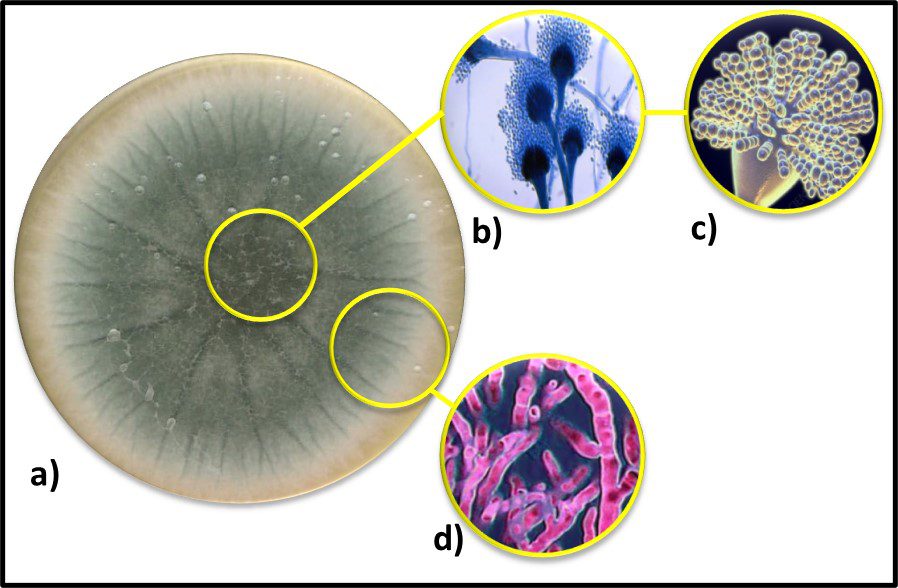
Fig 3. Ascomycota – a) Aspergillus fumigatus colony; b) spore-bearing conidiophores; c) close-up of conidiospores on a conidiophore; d) vegetative hyphae.
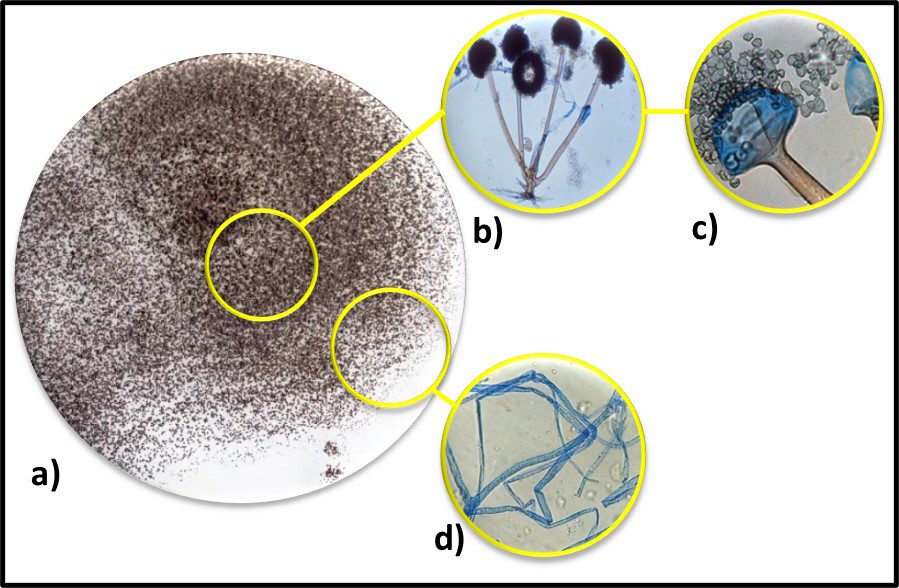
Fig 4. Mucromycota – a) Rhizopus sp. Colony; b) spore-bearing sporangiophores; c) close-up of a sporangiophore with sporangiospores; d) vegetative rhizoids.
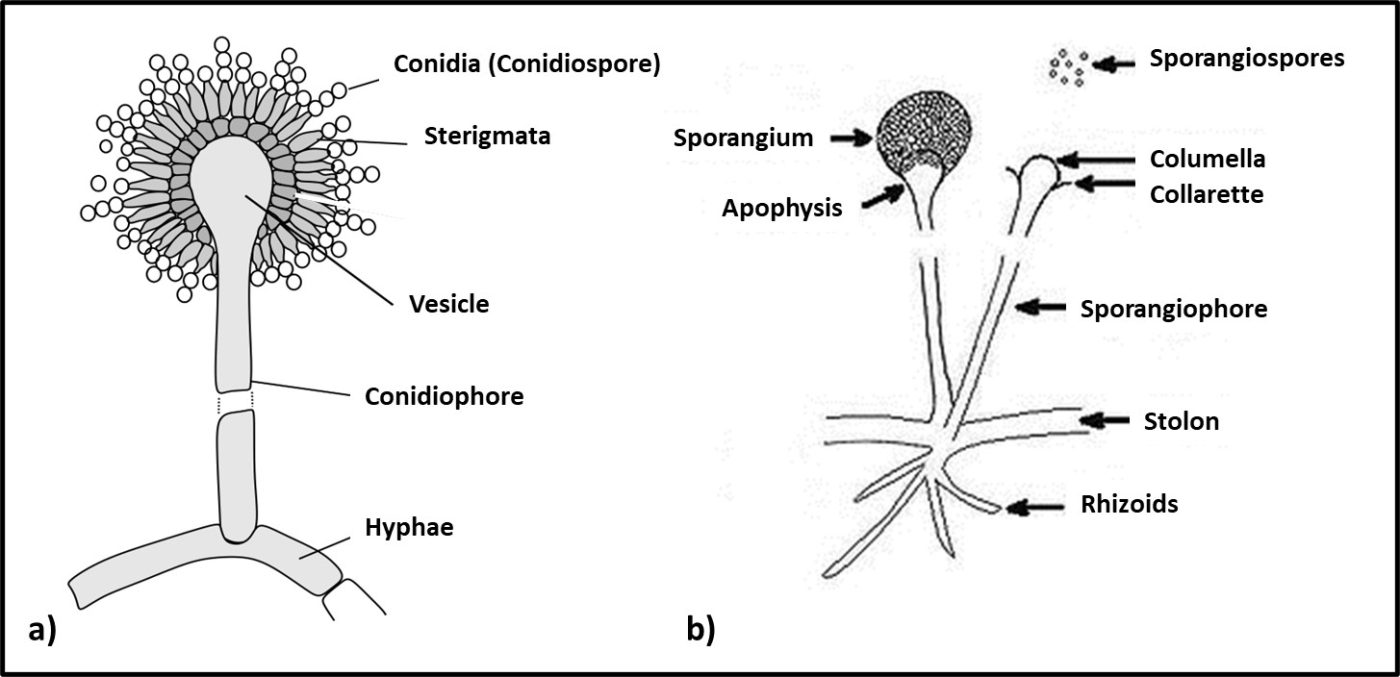
Fig 5. Mold morphology – a) Ascomycota; b) Mucormycota.
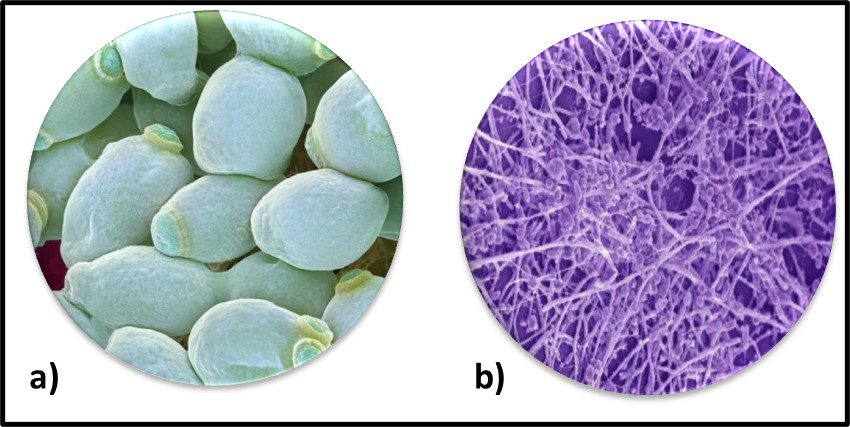
Fig 6. Dimorphic fungus Candida albicans – a) yeast form; b) mold form.
Fungus reproduction
The life cycles of Ascomycetes and Mucoromycetes (Zygomycetes) are similar. As noted above both divisions reproduce sexually and asexually. Spores are formed during asexual reproduction and can persist for centuries until conditions are favorable for germination. Yeasts reproduce by budding (see July 2024, Figure 5). For filamentous forms, most fungal biomass is in the vegetative hyphae. Masses of fungal filaments have been discovered that weigh several metric tons and occupy 1,000s of m3. In liquids such as fuels, lubricants and metalworking fluids, molds typically form spherical colonies. When the aerial hyphae (spore-bearing bodies) develop on the inside of the colony, the spheres are smooth and slimy (Figure 7a – I call these fisheyes). When the areal hyphae develop facing the outside, the spheres are fuzzy (Figure 7b – I call spheres in this form scuzzballs). Fungal growth at the fuel-water interface can form thick, impenetrable masses (Figure 8a). Similar masses can form on MWF system surfaces (Figures 8b and 8c).

Fig 7. Spherical fungal colonies in liquid – a) fisheyes (aerial hyphae are inside of the sphere); b) scuzzballs (areal hyphae are outside the sphere).
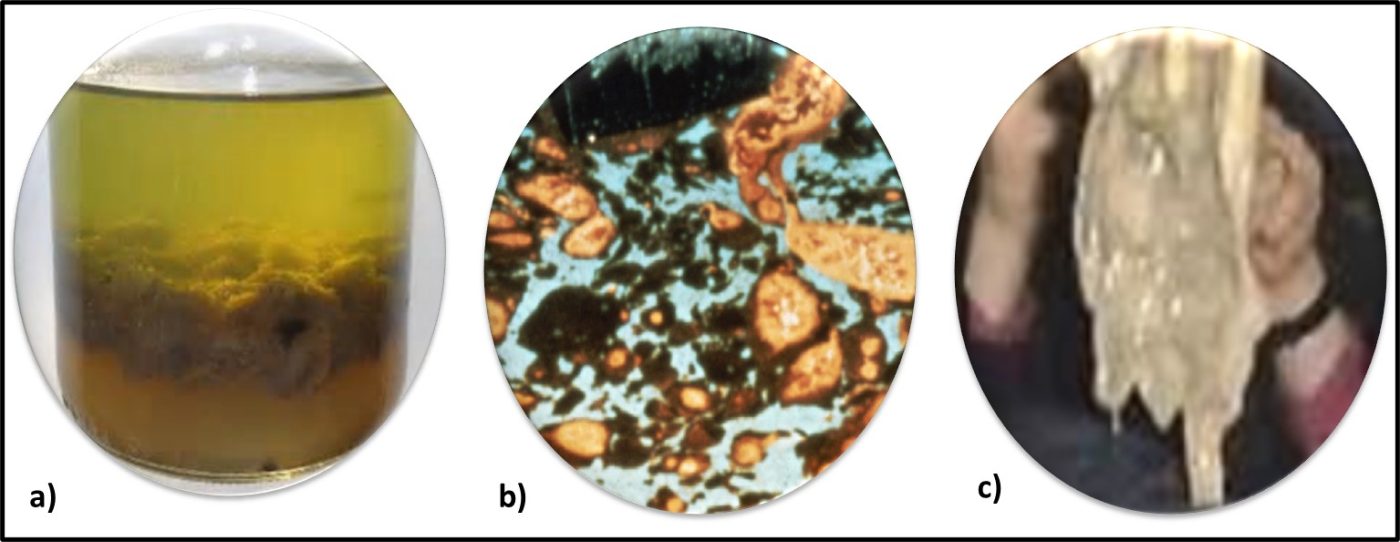
Fig 8. Fungal masses in fluid systems – a) fungal mat at fuel-water interface; b) mold colonies on surface of water-miscible metalworking fluid (MWF) in 50 L sump; c) membranous fungal mass pulled off of MWF sluice.
Physiology
In previous posts, I’ve commented that all organisms need water to grow and proliferate. As a kingdom, fungi need less water than bacteria. Water activity (aw is a measure of water’s availability in a solvent). Bacteria typically become dormant when aw ≤0.9. Most fungi can thrive at aw ≥ 0.7. Bacterial grow optimally in the pH 6 to 8 range but fungi prefer pH 5 to 6.
The fungi that infect industrial process fluid systems such as fuel and metalworking fluids can typically proliferate on simple sugars such as glucose. However, many taxa are nutritionally adaptable and can use a variety of organic molecules – including hydrocarbons – as their sole carbon source. Hormoconus resinae, one of the fungal species commonly recovered from fuels, has been shown to degrade ultra-low sulfur diesel (ULSD) by > 60 % (w/w) in < 30 days under laboratory conditions. Degradation includes mineralization to carbon dioxide, partial fuel molecule breakdown (for example aromatics to aliphatics), conversion to new biomass, and metabolism to waste products. There are thousands of volatile, fungal metabolites (MVOC – microbial volatile organic compounds). Many are allergenic – commonly causing sick building syndrome in homes and commercial buildings. Some (e.g., aflatoxin produced by some Aspergillus species) are carcinogenic. Mycotoxins (including hallucinogens) are toxic metabolites produced by fungi. MVOC are primarily associated with fungal spores. Despite the variety of MVOCs, the predominant odors associated with fungal contamination are yeasty or musty (think of a locker room, old damp house, or pile of rotting potatoes). Few studies have investigated MVOC concentrations in industrial facilities. Health and safety studies that have performed at facilities using water-miscible metalworking fluids (MWF) suggest that health risks associated with MVOC exposure do not add significantly to those posed by overall exposure to MWF mist.
Summary
Historically thought to be just one evolutionary step after the bacteria, the domain Fungi is now recognized to be genetically close to plants and animals on the tree of life. Taxonomically and morphologically diverse as a kingdom, the morphological forms that infect industrial systems are yeasts and molds. Because of the masses of filamentous, vegetative hyphae they form, fungi are commonly responsible for plugging lines, filters, and parts washer screens. Fungal MVOC can be noxious, allergenic, toxic, and carcinogenic. Most commonly, fungi are found in multi-organism consortia that include bacteria.
As always, please share your comments and questions with me at fredp@biodeterioration-control.com.

